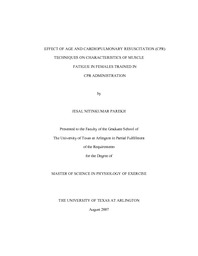
ATTENTION: The works hosted here are being migrated to a new repository that will consolidate resources, improve discoverability, and better show UTA's research impact on the global community. We will update authors as the migration progresses. Please see MavMatrix for more information.
Show simple item record
| dc.contributor.author | Parekh, Jesal N | en_US |
| dc.date.accessioned | 2007-09-17T17:07:34Z | |
| dc.date.available | 2007-09-17T17:07:34Z | |
| dc.date.issued | 2007-09-17T17:07:34Z | |
| dc.date.submitted | August 2007 | en_US |
| dc.identifier.other | DISS-1832 | en_US |
| dc.identifier.uri | http://hdl.handle.net/10106/619 | |
| dc.description.abstract | Cardio pulmonary resuscitation (CPR) is a widely popular and recommended assessment and intervention technique for life threatening conditions resulting from cardio-pulmonary disorders. As per the American Heart Association® 2005 revised guidelines for CPR administration, the rescuer is required to perform chest compressions and ventilations in the ratio of 30:2 at a rate of 100 compressions per minute with minimal interruption to chest compressions. In the process of CPR administration, the rescuer is likely to experience fatigue over time with continual compressions and ventilations. Fatigue is expected to manifest through variations in the rescuer's muscle activity, changes in joint kinetics and kinematics (angles, acceleration of movement etc.), increases in blood lactate concentration, decrease in depth and rate of chest compressions, increases in ventilation duration and delay in resuming chest compressions after ventilations. Overall, the changes may significantly affect the quality of CPR administered. Twenty subjects, ten females in the age group of 22-35 years and ten females in the age group of 45-60 years, competent in basic life support and currently certified to administer CPR as per American Heart Association® 2005 guidelines were evaluated as they performed CPR with compressions only and CPR with compressions and ventilations (30:2) continuously on a SkillReporter Resusci® Anne (Laerdal®, NY) until self-identified fatigue settled in (identified as exertion on Borg's scale) or to a maximum of 10 minutes. The subjects were assessed for fatigue related changes in biomechanical parameters (joint kinematics and kinetics), electrical activity of the muscle or electromyogram (EMG), blood lactate concentration and quality of CPR administered in either case. | en_US |
| dc.description.sponsorship | Ricard, Mark D. | en_US |
| dc.language.iso | EN | en_US |
| dc.publisher | Kinesiology | en_US |
| dc.title | Effects Of Age And Cardiopulmonary Resuscitation (CPR) Techniques On Characteristics Of Muscle Fatigue In Females Trained In CPR Administration | en_US |
| dc.type | M.S. | en_US |
| dc.contributor.committeeChair | Ricard, Mark D. | en_US |
| dc.degree.department | Kinesiology | en_US |
| dc.degree.discipline | Kinesiology | en_US |
| dc.degree.grantor | University of Texas at Arlington | en_US |
| dc.degree.level | masters | en_US |
| dc.degree.name | M.S. | en_US |
| dc.identifier.externalLink | https://www.uta.edu/ra/real/editprofile.php?onlyview=1&pid=445 | |
| dc.identifier.externalLinkDescription | Link to Research Profiles | |
Files in this item
- Name:
- umi-uta-1832.pdf
- Size:
- 2.345Mb
- Format:
- PDF
This item appears in the following Collection(s)
Show simple item record


